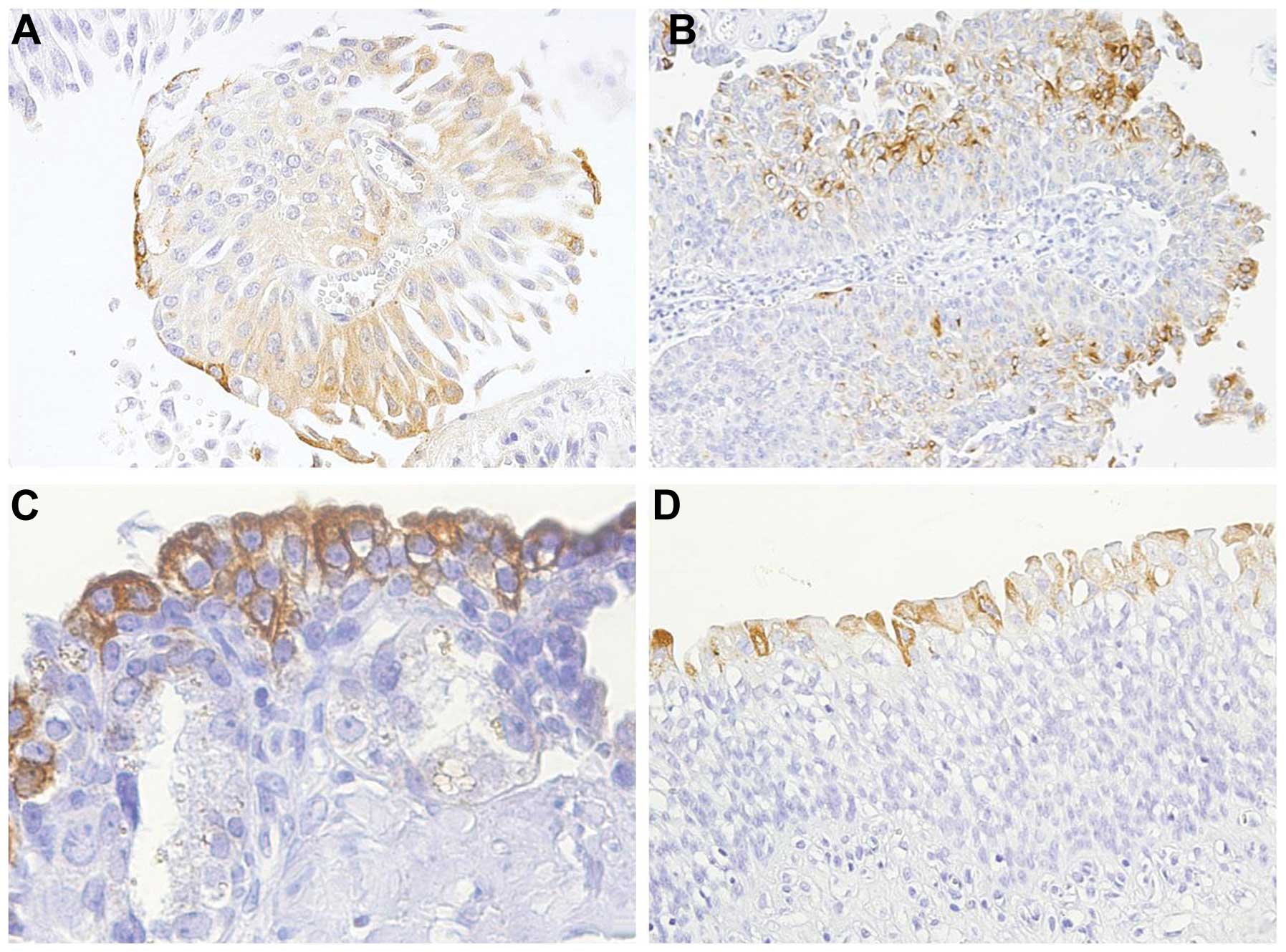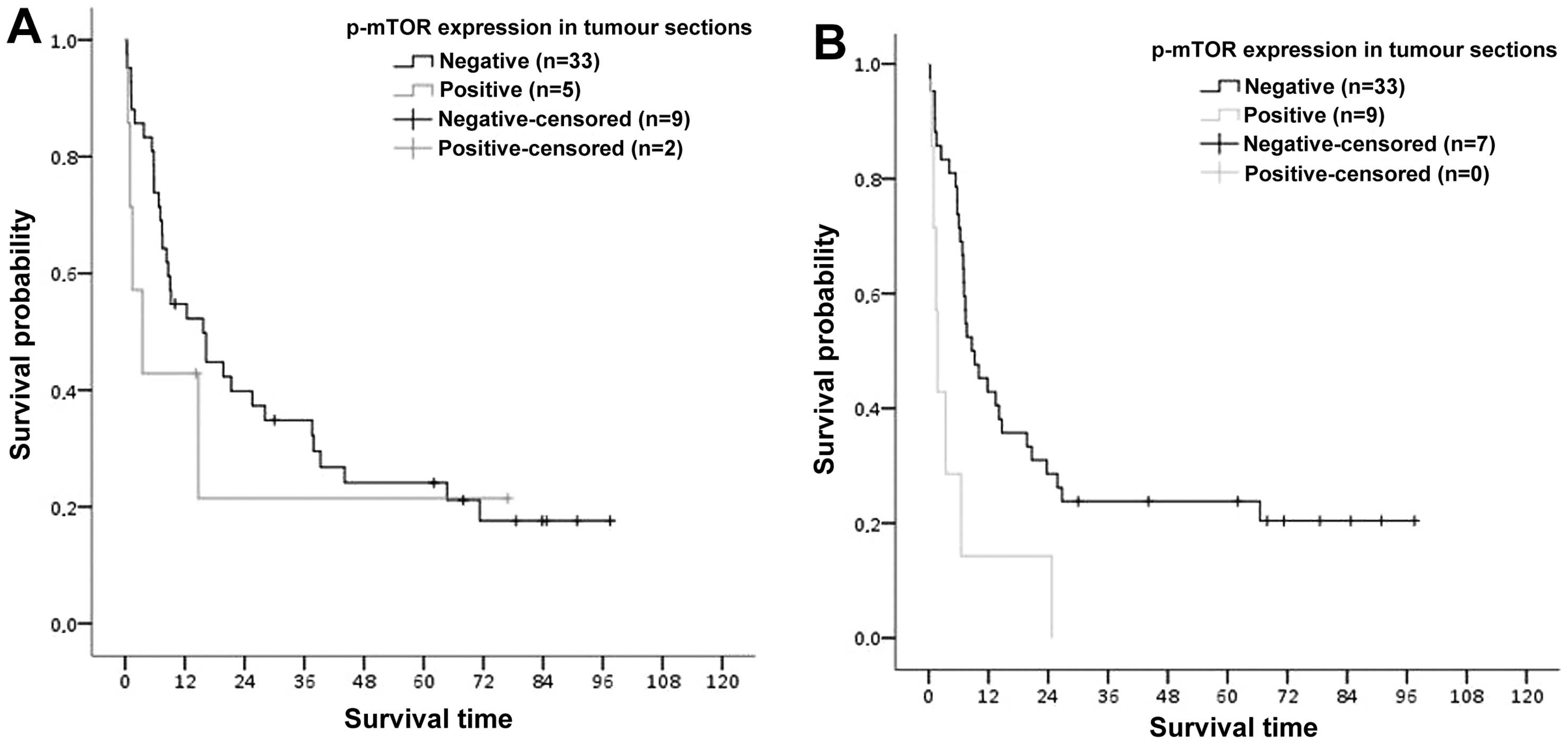|
1
|
Jemal A, Bray F, Center MM, et al: Global
cancer statistics. CA Cancer J Clin. 61:69–90. 2011.
|
|
2
|
Reuter VE: The pathology of bladder
cancer. Urology. 67:11–17. 2006.
|
|
3
|
Colombel M, Soloway M, Akaza H, et al:
Epidemiology, staging, grading, and risk stratification of bladder
cancer. Eur Urol Suppl. 7:618–626. 2008.
|
|
4
|
Cheung G, Sahai A, Billia M, Dasgupta P
and Khan MS: Recent advances in the diagnosis and treatment of
bladder cancer. BMC Med. 11:132013.
|
|
5
|
Kaufman DS, Shipley WU and Feldman AS:
Bladder cancer. Lancet. 374:239–249. 2009.
|
|
6
|
Shariat SF, Karakiewicz PI, Palapattu GS,
et al: Outcomes of radical cystectomy for transitional cell
carcinoma of the bladder: a contemporary series from the Bladder
Cancer Research Consortium. J Urol. 176:2414–2422; discussion
2422–2006.
|
|
7
|
Bellmunt J, Orsola A, Wiegel T, et al:
Bladder cancer: ESMO Clinical Practice Guidelines for diagnosis,
treatment and follow-up. Ann Oncol. 22(Suppl 6): vi45–vi49.
2011.
|
|
8
|
Strimpakos AS, Karapanagiotou EM, Saif MW
and Syrigos KN: The role of mTOR in the management of solid tumors:
an overview. Cancer Treat Rev. 35:148–159. 2009.
|
|
9
|
Rosner M, Hanneder M, Siegel N, et al: The
mTOR pathway and its role in human genetic diseases. Mutat Res.
659:284–292. 2008.
|
|
10
|
Dobashi Y, Watanabe Y, Miwa C, Suzuki S
and Koyama S: Mammalian target of rapamycin: a central node of
complex signaling cascades. Int J Clin Exp Pathol. 4:476–495.
2011.
|
|
11
|
Zhou H and Huang S: Role of mTOR signaling
in tumor cell motility, invasion and metastasis. Curr Protein Pept
Sci. 12:30–42. 2011.
|
|
12
|
Karar J and Maity A: PI3K/AKT/mTOR pathway
in angiogenesis. Front Mol Neurosci. 4:512011.
|
|
13
|
Faivre S and Raymond E: Mechanism of
action of rapalogues: the antiangiogenic hypothesis. Expert Opin
Investig Drugs. 17:1619–1621. 2008.
|
|
14
|
Dormond-Meuwly A, Roulin D, Dufour M, et
al: The inhibition of MAPK potentiates the anti-angiogenic efficacy
of mTOR inhibitors. Biochem Biophys Res Commun. 407:714–719.
2011.
|
|
15
|
Menon S and Manning BD: Common corruption
of the mTOR signaling network in human tumors. Oncogene.
27:S43–S51. 2008.
|
|
16
|
Ueng SH, Chen SC, Chang YS, et al:
Phosphorylated mTOR expression correlates with poor outcome in
early-stage triple negative breast carcinomas. Int J Clin Exp
Pathol. 5:806–813. 2012.
|
|
17
|
Leal P, García P, Sandoval A, et al:
Immunohistochemical expression of phospho-mTOR is associated with
poor prognosis in patients with gallbladder adenocarcinoma. Arch
Pathol Lab Med. 137:552–557. 2013.
|
|
18
|
An JY, Kim KM, Choi MG, et al: Prognostic
role of p-mTOR expression in cancer tissues and metastatic lymph
nodes in pT2b gastric cancer. Int J Cancer. 126:2904–2913.
2010.
|
|
19
|
Rai JS, Henley MJ and Ratan HL: Mammalian
target of rapamycin: a new target in prostate cancer. Urol Oncol.
28:134–138. 2010.
|
|
20
|
Herberger B, Puhalla H, Lehnert M, et al:
Activated mammalian target of rapamycin is an adverse prognostic
factor in patients with biliary tract adenocarcinoma. Clin Cancer
Res. 13:4795–4799. 2007.
|
|
21
|
Faried LS, Faried A, Kanuma T, et al:
Expression of an activated mammalian target of rapamycin in
adenocarcinoma of the cervix: A potential biomarker and molecular
target therapy. Mol Carcinog. 47:446–457. 2008.
|
|
22
|
Darb-Esfahani S, Faggad A, Noske A, et al:
Phospho-mTOR and phospho-4EBP1 in endometrial adenocarcinoma:
association with stage and grade in vivo and link with response to
rapamycin treatment in vitro. J Cancer Res Clin Oncol.
135:933–941. 2009.
|
|
23
|
Bradshaw-Pierce EL, Pitts TM, Kulikowski
G, et al: Utilization of quantitative in vivo pharmacology
approaches to assess combination effects of everolimus and
irinotecan in mouse xenograft models of colorectal cancer. PLoS
One. 8:e580892013.
|
|
24
|
Frost P, Berlanger E, Mysore V, et al:
Mammalian target of rapamycin inhibitors induce tumor cell
apoptosis in vivo primarily by inhibiting VEGF expression and
angiogenesis. J Oncol. 2013:8970252013.
|
|
25
|
O’Reilly T, McSheehy PM, Wartmann M, et
al: Evaluation of the mTOR inhibitor, everolimus, in combination
with cytotoxic antitumor agents using human tumor models in vitro
and in vivo. Anticancer Drugs. 22:58–78. 2011.
|
|
26
|
Cejka D, Preusser M, Fuereder T, et al:
mTOR inhibition sensitizes gastric cancer to alkylating
chemotherapy in vivo. Anticancer Res. 28:3801–3808. 2008.
|
|
27
|
Fasolo A and Sessa C: Targeting mTOR
pathways in human malignancies. Curr Pharm Des. 18:2766–2777.
2012.
|
|
28
|
Nelson V, Altman JK and Platanias LC: Next
generation of mammalian target of rapamycin inhibitors for the
treatment of cancer. Expert Opin Investig Drugs. 22:715–722.
2013.
|
|
29
|
Gentzler RD, Altman JK and Platanias LC:
An overview of the mTOR pathway as a target in cancer therapy.
Expert Opin Ther Targets. 16:481–489. 2012.
|
|
30
|
Serrano C, Morales R, Suárez C, et al:
Emerging therapies for urothelial cancer. Cancer Treat Rev.
38:311–317. 2012.
|
|
31
|
Hansel DE, Platt E, Orloff M, et al:
Mammalian target of rapamycin (mTOR) regulates cellular
proliferation and tumor growth in urothelial carcinoma. Am J
Pathol. 176:3062–3072. 2010.
|
|
32
|
Makhlin I, Zhang J, Long CJ, et al: The
mTOR pathway affects proliferation and chemosensitivity of
urothelial carcinoma cells and is upregulated in a subset of human
bladder cancers. BJU Int. 108:E84–E90. 2011.
|
|
33
|
Amin MB, Srigley JR, Grignon DJ, et al:
Urinary bladder cancer protocols and checklists. College of
American Pathologists; Northfield, IL: 2005
|
|
34
|
Edge SB, Byrd DR, Compton CC, Fritz AG,
Greene FL and Trotti A: AJCC Cancer Staging Manual. 7th Edition.
Springer Verlag; New York, NY: pp. 497–506. 2010
|
|
35
|
Mostofi FK, Davis CJ Jr and Sesterhenn IA:
Histological typing of urinary bladder tumours. World Health
Organization, International Histological Classification of Tumours.
2nd Edition. Springer Verlag; New York, NY: pp. 3–30. 1999
|
|
36
|
Eble JN, Sauter G, Epstein JI and
Sesterhenn IA: World Health Organization Classification of Tumours.
Pathology and Genetics of Tumours of the Urinary System and Male
Genital Organs. IARC Press; Lyon: 2004
|
|
37
|
Afonso J, Santos LL, Amaro T, Lobo F and
Longatto-Filho A: The aggressiveness of urothelial carcinoma
depends to a large extent on lymphovascular invasion - the
prognostic contribution of related molecular markers.
Histopathology. 55:514–524. 2009.
|
|
38
|
Sato T, Nakashima A, Guo L, Coffman K and
Tamanoi F: Single amino-acid changes that confer constitutive
activation of mTOR are discovered in human cancer. Oncogene.
29:2746–2752. 2010.
|
|
39
|
Knowles MA, Platt FM, Ross RL and Hurst
CD: Phosphatidylinositol 3-kinase (PI3K) pathway activation in
bladder cancer. Cancer Metastasis Rev. 28:305–316. 2009.
|
|
40
|
Polette M, Nawrocki-Raby B, Gilles C,
Clavel C and Birembaut P: Tumour invasion and matrix
metalloproteinases. Crit Rev Oncol Hematol. 49:179–186. 2004.
|
|
41
|
Pinto-Leite R, Botelho P, Ribeiro E,
Oliveira PA and Santos L: Effect of sirolimus on urinary bladder
cancer T24 cell line. J Exp Clin Cancer Res. 28:32009.
|
|
42
|
Pinto-Leite R, Arantes-Rodrigues R,
Palmeira C, et al: Everolimus combined with cisplatin has a
potential role in treatment of urothelial bladder cancer. Biomed
Pharmacother. 67:116–121. 2013.
|
|
43
|
Pinto-Leite R, Arantes-Rodrigues R,
Palmeira C, et al: Everolimus enhances gemcitabine-induced
cytotoxicity in bladder-cancer cell lines. J Toxicol Environ Health
A. 75:788–799. 2012.
|
|
44
|
Seager CM, Puzio-Kuter AM, Patel T, et al:
Intravesical delivery of rapamycin suppresses tumorigenesis in a
mouse model of progressive bladder cancer. Cancer Prev Res (Phila).
2:1008–1014. 2009.
|
|
45
|
Seront E, Rottey S, Sautois B, et al:
Phase II study of everolimus in patients with locally advanced or
metastatic transitional cell carcinoma of the urothelial tract:
clinical activity, molecular response, and biomarkers. Ann Oncol.
23:2663–2670. 2012.
|
|
46
|
Copp J, Manning G and Hunter T:
TORC-specific phosphorylation of mammalian target of rapamycin
(mTOR): phospho-Ser2481 is a marker for intact mTOR signaling
complex 2. Cancer Res. 69:1821–1827. 2009.
|
|
47
|
Korkolopoulou P, Levidou G, Trigka EA, et
al: A comprehensive immunohistochemical and molecular approach to
the PI3K/AKT/mTOR (phosphoinositide 3-kinase/v-akt murine thymoma
viral oncogene/mammalian target of rapamycin) pathway in bladder
urothelial carcinoma. BJU Int. 110:E1237–E1248. 2012.
|
|
48
|
Sun CH, Chang YH and Pan CC: Activation of
the PI3K/Akt/mTOR pathway correlates with tumour progression and
reduced survival in patients with urothelial carcinoma of the
urinary bladder. Histopathology. 58:1054–1063. 2011.
|
|
49
|
Schultz L, Albadine R, Hicks J, et al:
Expression status and prognostic significance of mammalian target
of rapamycin pathway members in urothelial carcinoma of urinary
bladder after cystectomy. Cancer. 116:5517–5526. 2010.
|
|
50
|
Park SJ, Lee TJ and Chang IH: Role of the
mTOR pathway in the progression and recurrence of bladder cancer:
an immunohistochemical tissue microarray study. Korean J Urol.
52:466–473. 2011.
|
|
51
|
Apodaca G: The uroepithelium: not just a
passive barrier. Traffic. 5:117–128. 2004.
|
|
52
|
Khandelwal P, Abraham SN and Apodaca G:
Cell biology and physiology of the uroepithelium. Am J Physiol
Renal Physiol. 297:F1477–1501. 2009.
|
|
53
|
Gibbons JJ, Abraham RT and Yu K: Mammalian
target of rapamycin: discovery of rapamycin reveals a signaling
pathway important for normal and cancer cell growth. Semin Oncol.
36:S3–S17. 2009.
|
|
54
|
Yecies JL and Manning BD: mTOR links
oncogenic signaling to tumor cell metabolism. J Mol Med (Berl).
89:221–228. 2011.
|
|
55
|
Yecies JL and Manning BD: Transcriptional
control of cellular metabolism by mTOR signaling. Cancer Res.
71:2815–2820. 2011.
|
|
56
|
Fahmy M, Mansure JJ, Brimo F, et al:
Relevance of the mammalian target of rapamycin pathway in the
prognosis of patients with high-risk non-muscle invasive bladder
cancer. Hum Pathol. 44:1766–1772. 2013.
|
|
57
|
Müller J, Ehlers A, Burkhardt L, et al:
Loss of pSer2448-mTOR expression is linked to adverse prognosis and
tumor progression in ERG-fusion-positive cancers. Int J Cancer.
132:1333–1340. 2013.
|
















